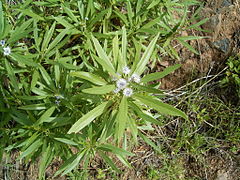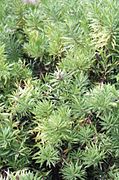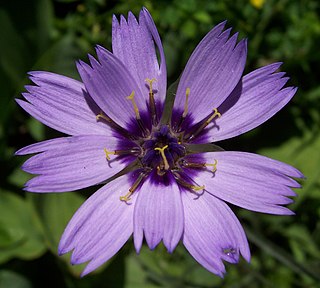
Catananche caerulea, Cupid's dart, is a greyish green perennial herbaceous plant with a basal leaf rosette and conspicuous blue-purple or sometimes white flowerheads, belonging to the daisy family. It is a popular garden plant and is often used in dried flower arrangements.

Stachys byzantina, the lamb's-ear or woolly hedgenettle, is a species of flowering plant in the mint family Lamiaceae, native to Armenia, Iran, and Turkey. It is cultivated over much of the temperate world as an ornamental plant, and is naturalised in some locations as an escapee from gardens. Plants are very often found under the synonym Stachys lanata or Stachys olympica.

Sideroxylon mirmulans, commonly known as marmulano, is a species of flowering plants in the family Sapotaceae. It is endemic to the Madeira Islands (Portugal). It is threatened by habitat loss.

Hypericum canariense is a species of flowering plant in the family Hypericaceae known by the common name Canary Islands St. John's wort. It is the sole member of Hypericumsect. Webbia.

Olearia phlogopappa commonly known as the dusty daisy-bush or alpine daisy-bush is a species of flowering plant in the family Asteraceae that is commonly found in eastern New South Wales, Victoria and Tasmania. It is a small shrub with greyish-green foliage, daisy-like flowers in white, pink or mauve that can be seen from spring to late summer.
Bulbophyllum xanthornis is a species of orchid in the genus Bulbophyllum.
Cavea is a low perennial herbaceous plant that is assigned to the daisy family. Cavea tanguensis is currently the only species assigned to this genus. It has a basal rosette of entire, slightly leathery leaves, and stems of 5–25 cm high, topped by bowl-shaped flower heads with many slender florets with long pappus and purplish corollas. The vernacular name in Chinese is 葶菊. It grows high in the mountains of China (Sichuan), Tibet, India (Sikkim), and Bhutan, and flowers in July and August.

Leucas aspera is a plant species within the genus Leucas and the family Lamiaceae. Although the species has many different common names depending on the region in which it is located, it is most commonly known as Thumbai or Thumba. Found throughout India, it is known for its various uses in the fields of medicine and agriculture.
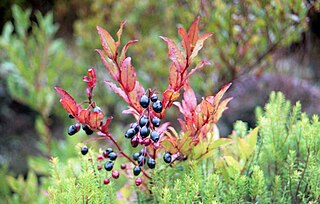
Vaccinium padifolium is very common at elevations between 800 and 1,700 metres. It grows mainly in crevices and exposed slopes and mountain plains. Fruits are used in preserves. It is endemic to the islands of Madeira and Porto Santo, Portugal.

Sideritis candicans. More or less white to greyish, densely tomentose shrub 45–100 cm. Leaves 2.5-12 x 1.5 x 7.5 cm, the lower ovate-lanceolate to ovate, acute to obtuse, rounded to cordate at base, weakly crenate to sub-entire, petiolate. Inflorescence up to 30 cm. Calyx 5–6.5 mm; teeth 1–1.5 mm. Corolla creamy yellow; tube 4–5.5 mm not exserted; upper lip 23–2.5 mm; lower lip 2.2-3.5 mm, the middle lobe shallowly notched. Nutlets 1.5 mm, ovoid. Flowers from Mars to July. Widespread in clearings and open sunny places mostly from 600 to 1700 m. Endemic to the islands of Madeira, Porto Santo and Bugio.

Globularia amygdalifolia is a flowering plant of the family Plantaginaceae. The species is endemic to Cape Verde. It is listed as an endangered species by the IUCN.
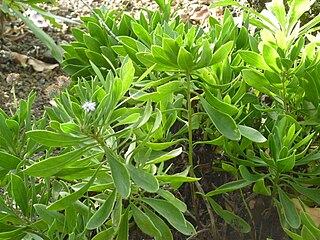
Globularia sarcophylla is a plant endemic to Gran Canaria, where it is rare and confined to basalt mountain cliffs of the Caldera de Tirajana, Los Leales, La Culata etc. around 1,600 m (5,200 ft) in elevation. Its leaves small, obovate, fleshy, about 2 cm (0.79 in) long. The flowers are blue. Flower heads are solitary about 1.5 cm (0.59 in) across, on 5–6 cm (2.0–2.4 in) long terminal peduncles.

Viburnum australe, known by the common name Mexican arrowwood, is a woody plant in the family Adoxaceae. It is found in northeastern Mexico and western Texas.
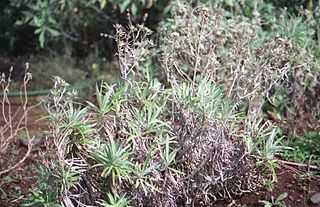
Carlina salicifolia is a species of thistle found in Macaronesia.

Karomia speciosa is an African deciduous large shrub or bushy tree up to 7 m, and relocated to the family Lamiaceae from Verbenaceae. It is one of 9 species in the genus Karomia, a genus containing species previously classified in Holmskioldia, and is closely related to Clerodendrum. The only remaining species in the genus is Holmskioldia sanguinea, occurring in the foothills of the Himalayas.
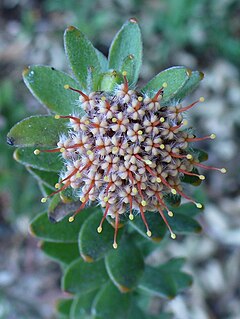
Leucospermum truncatulum is a slender, upright, evergreen, hardly branching shrub of up to 2 m (6 ft) high, with felty inverted egg-shaped to oval, leaves with entire margins of 1–2½ cm (0.4–1.0 in) long and ½–1 cm (0.2–0.4 in) wide. It has small globe-shaped, at first yellow, later pinkish flower heads of 1½–2 cm (0.6-0.8 in) in diameter, without a stalk, usually crowded with two to eight together near the end of the stems. It is known as oval-leaf pincushion in English, and patrysbos or kleinkopspeldekussing in Afrikaans. It is an endemic species of the south of the Western Cape province of South Africa, and flowers between August and December.

Acer diabolicum, the horned maple or devil maple, is a species of maple that is endemic to central and southern Japan. There it is known as カジカエデ, kaji kaede or オニモミジ, oni‑momiji, and is planted as an ornamental. It is occasionally planted as an ornamental outside Japan. It gets its specific epithet and its common names from the two hornlike appearance of the protruding curly stigmas of its flowers, which are retained on its winged seeds.
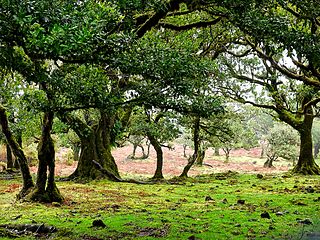
The Madeira evergreen forests is a temperate broadleaf and mixed forests ecoregion of southwestern Europe. It covers the archipelago of Madeira and some nearby islands in the Atlantic Ocean. Laurel forest, known as laurissilva, once covered the islands. Over centuries the forests were mostly cleared. Madeira's remaining forests are now protected.
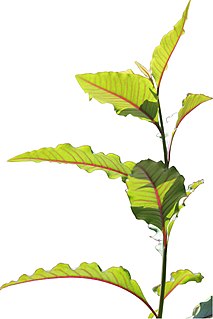
Bosea yervamora Is a shrub up to 3 m with greenish slender branches. Leaves up to 7 cm long, ovate, lanceolate, alternate, short stalked, without hair. Flowers short terminal, arising from the axil of the leaf, indefinite inflorescences, greenish with two membranous, dry modified leaves at the base of the stem. Fruits greenish black turning pink when ripe, about the size of a small pea.

Lepanthes kokonuko is a species of orchid from southern Colombia. L. kokonuko can be easily recognized by its caespitose medium-sized plants, elliptical coriaceous leaves, long loosely, flexuous and distichous inflorescences; strongly revolute lateral sepals, transversely bilobed petals with the upper lobe lanceolate (hornlike), and a bilaminate lip with the blades ovoid–lanceolate with a bipartite appendix.



